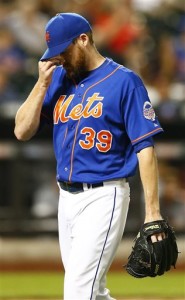 With the trade deadline steadily approaching (on July 31st), several players will inevitably find themselves playing for new teams. The focus of the deadline–at least from an analytical perspective–is usually the high powered team(s) that acquire the one or two “difference makers,” with the hopes of propelling themselves into the playoffs. However, the “sellers” experience big roster changes too.
With the trade deadline steadily approaching (on July 31st), several players will inevitably find themselves playing for new teams. The focus of the deadline–at least from an analytical perspective–is usually the high powered team(s) that acquire the one or two “difference makers,” with the hopes of propelling themselves into the playoffs. However, the “sellers” experience big roster changes too.
In the case of trading veteran closers, “sellers” often turn to comparatively inexperienced setup men or middle relievers in the ninth inning to fill the void. A good example from last deadline was Jonathan Broxton and Greg Holland. The Kansas City Royals dealt Broxton to the Cincinnati Reds, and promoted dominant setup man Holland into the role.
As a first time closer, Holland posted a 2.17 ERA (versus a park-adjusted 3.24 xFIP), 1.07 WHIP, 3.36 K/BB, and 16 saves. So far in 2013, Holland–who is still closing for the Royals–has pitched to the tune of a 2.10 ERA (versus 1.67 xFIP), 1.00 WHIP, 4.55 K/BB, and 17 saves.
Perhaps the most highly speculated on-the-move closer is Philadelphia Phillies’ stopper Jonathan Papelbon. Papelbon has pitched a 2.05 ERA (versus 3.77 xFIP), 0.88 WHIP, 5.40 K/BB, and 15 saves for the lowly Phillies. The Phils are currently five games below .500, and have been rumored to be dangling high-salaried veterans like Papelbon.
 If the 32-year-old reliever were to be traded, it’s likely that Antonio Bastardo would take over the reins. Bastardo, 27, hasn’t been nearly as good in 2013 (4.67 xFIP) as he has in 2012 (3.18 xFIP) or 2011 (3.56 xFIP), but he’d just be a stopgap for Kenneth Giles, a top relief prospect for the Phillies. Giles could potentially take over the closing gig in 2014 (or possibly closer to the second half of 2014).
If the 32-year-old reliever were to be traded, it’s likely that Antonio Bastardo would take over the reins. Bastardo, 27, hasn’t been nearly as good in 2013 (4.67 xFIP) as he has in 2012 (3.18 xFIP) or 2011 (3.56 xFIP), but he’d just be a stopgap for Kenneth Giles, a top relief prospect for the Phillies. Giles could potentially take over the closing gig in 2014 (or possibly closer to the second half of 2014).
 As for the San Diego Padres, the second half of 2013 could finally be the time the organization allows Luke Gregerson to close full time.
As for the San Diego Padres, the second half of 2013 could finally be the time the organization allows Luke Gregerson to close full time.
The usually consistent Huston Street, who is under contract for $7 million next season, has been an albatross so far in 2013, posting a dismal 4.61 ERA (versus 4.90 xFIP), 1.31 WHIP, 1.88 K/BB, and 15 saves.
By comparison, Gregerson has hurled a 2.60 ERA (versus 3.24 xFIP), 1.01 WHIP, and 3.75 K/BB. Even though Gregerson and Street are both 29 years old, the former still has a remaining year of arbitration (and is thus a cheaper closing option). Given Street’s down season, the Padres might have trouble marketing the right-hander as a closer, but other teams should still have interest in the former first rounder as a solid setup option.
 Even though the New York Mets’ bullpen is a major point of weakness, the team could still look to trade closer Bobby Parnell if suitors offer a big enough package.
Even though the New York Mets’ bullpen is a major point of weakness, the team could still look to trade closer Bobby Parnell if suitors offer a big enough package.
Parnell has posted a 2.68 ERA (versus 3.14 xFIP), 0.91 WHIP, 3.88 K/BB, and 14 saves. What makes the 28-year-old particularly valuable is that he still has two years of team control.
The last time a major league team dealt a team-controlled closer was in 2010, when the Washington Nationals traded Matt Capps to the Minnesota Twins for catcher Wilson Ramos.
At the time, Ramos was a highly touted prospect (ranked fourth on John Sickels’ pre-2010 Twins’ organization list).
With the Detroit Tigers outwardly looking to acquire a closer, it’s possible the two team could match-up–especially if the Tigers dangled top outfield prospect Nick Castellanos.
Unlike the Padres or Phillies, however, the Mets don’t exactly have a setup man chomping at the bit.
The Mets would likely use either Brandon Lyon or David Aardsma in the role (assuming Frank Francisco does not return from injury this season).
There is no doubt that any contending team would improve their chances in 2013 by acquiring Papelbon, Parnell, and to a far lesser extent, Street, but for the “sellers,” nothing is a better test of an organization’s depth than filling a closer void from within.
